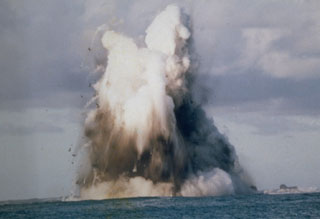Report on Nishinoshima (Japan) — 19 July-25 July 2017
Smithsonian Institution / US Geological Survey
Weekly Volcanic Activity Report, 19 July-25 July 2017
Managing Editor: Sally Sennert.
Please cite this report as:
Global Volcanism Program, 2017. Report on Nishinoshima (Japan) (Sennert, S, ed.). Weekly Volcanic Activity Report, 19 July-25 July 2017. Smithsonian Institution and US Geological Survey.
Nishinoshima
Japan
27.247°N, 140.874°E; summit elev. 100 m
All times are local (unless otherwise noted)
The Japan Coast Guard reported that visual observations of Nishinoshima from an aircraft during the afternoon of 11 July confirmed that the eruption was ongoing. Emissions from the center of the cone were grayish white and tephra was ejected. The lava flow on the W flank continued to enter the ocean. Based on a pilot observation the Tokyo VAAC reported that on 18 July an ash plume rose to 3 km (10,000 ft) a.s.l.
Geological Summary. The small island of Nishinoshima was enlarged when several new islands coalesced during an eruption in 1973-74. Multiple eruptions that began in 2013 completely covered the previous exposed surface and continued to enlarge the island. The island is the summit of a massive submarine volcano that has prominent peaks to the S, W, and NE. The summit of the southern cone rises to within 214 m of the ocean surface 9 km SSE.
Sources: Japan Coast Guard, Tokyo Volcanic Ash Advisory Center (VAAC)

